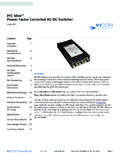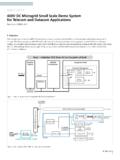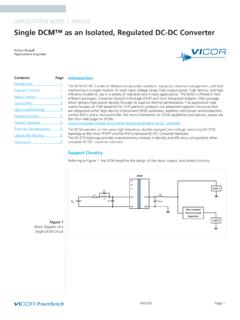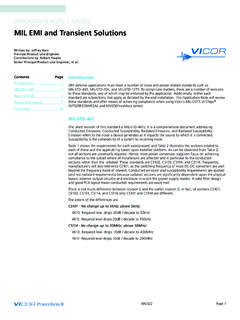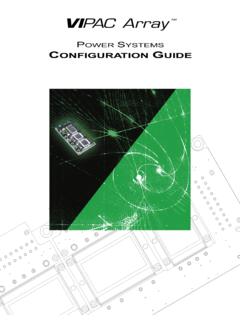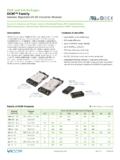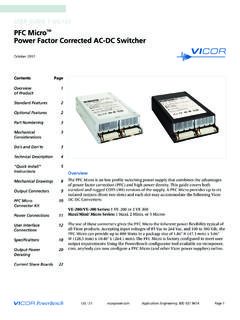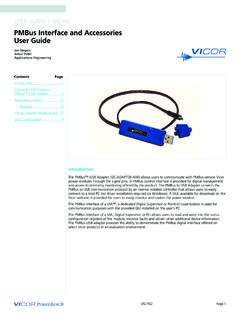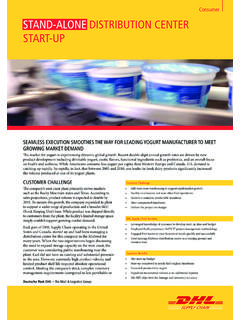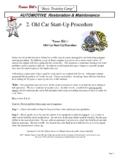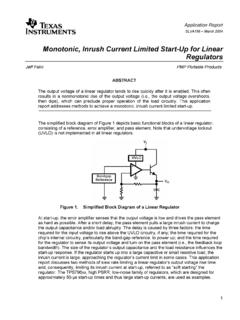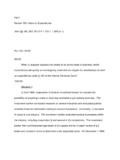Transcription of HV ChiP BCM Reverse Start Up Circuit - Vicor …
1 AN:038 Page 1 SummaryAn economical, robust Circuit for Reverse starting Vicor HV (High Voltage) chip (Converter Housed in Package) BCM (Bus Converter Module) engines with analog mode control is described. The way the Circuit works is and Arrangement of MaterialIn the conventional mode, a DC source voltage is applied to the primary or high voltage side of the BCM with its secondary port loaded. The BCM primary and secondary power ports are isolated. The BCM s controller is set on the primary side of the BCM. A BCM can be operated in another way, which is called Reverse mode [ref 6]. In this configuration, source and load are swapped with each other: the source is set across the secondary port and load set across the primary port.
2 To process power in this way, the BCM s controller has to primed first; once this is done, the primary port based load will receive power through the BCM with power sourced from the secondary app note presents a discrete component Circuit for automatic Start up of analog controlled, HV chip formatted BCMs in Reverse mode. The advent of routine BCM Reverse Start up opens up a wide field of applications. Examples of the use of a Reverse or bidirectional BCM are seen in battery and super capacitor conditioning circuits, EV automotive power harvesting, and in HV DC tether voltage generation for UAV and AUVs [refs 4 6]. This note will pave the way to resolve issues associated with the Start up of complex systems and the sequencing of power flow operations.
3 (Dealing with arrays of BCMs is beyond the scope of this application note. Vicor Applications Engineering should be contacted about these unique applications.)Much of the detail, associated with the BoM (bill of materials), waveform oscillograms of the operation of the primer and the like are provided in the and VTM power components are members of the SAC (sine amplitude converter) family. The internal controller sub systems of all SACs developed and manufactured to date are referenced to the primary side of their isolation barriers. In order to allow power flow through a SAC, irrespective of its direction, it is necessary to first activate the controller by feeding it a primary referenced supply chip BCMs that have no primary HV (High Voltage) energy source available can be started or primed with the low cost Circuit described herein.
4 The energy needed for Start up is transferred from a secondary LV (Low Voltage) DC source as a charge packet stream. This source is anticipated to be part of the mainstream application of the BCM: it is assumed to be permanently connected to the secondary side of the BCM. The trickle of current from the LV source is directed across the BCM s isolation barrier to a HUB (Hold up Capacitor). Once charged, the HUB is connected for a short time to the primary power port of the BCM. After Start up of the BCM and Reverse mode confirmation, the primer Circuit goes into a low power primer system comprises a pulse generator, a low power flyback converter, hold up capacitor (HUB), unidirectional switch and command and control logic.
5 The flyback power train has no linear feedback control loop installed. The power train is either ON or OFF, depending on the voltage of the hold up capacitor and its relation to the BCM s input voltage turn on threshold. A comparator and logic gating automatically sequences the Circuit s various phases of variations can be made to the Reverse BCM primer. The first adaptation makes it possible to accommodate some BCM applications that already have external filtering elements installed across the input port of the BCM. The second adaptation allows the Circuit to work with either low or high voltage secondary DC power sources. A third adaptation is available for adjusting the primer Circuit s turn on chip BCM Reverse Start Up CircuitAPPLICATION NOTE | AN.
6 038 David BournerContents PageSummary 1 Scope and Arrangement of Material 1 Introduction 1 Overview of Reverse Primer Circuit Action 2 Primer Circuit Details 3 HUB (Hold Up Capacitor) and HSW (HUB Switch) 6 Command and Control Circuit 8 Auxiliary DC Regulator 8 Summary 9 Disclaimer 9 References 9 Appendix 10 Tables 10 Oscillograms 10 Partitioned BoM for BCM Reverse Primer Circuit 11 Flyback Converter Block (Pulse Generator + Flyback Power Train) 11 HUB (Hold Up Capacitor) and HSW (HUB Switch) 11 Command and Control Circuit 12 Auxiliary Linear Regulator 12 AN.
7 038 Page 2 Overview of Reverse Primer Circuit Action Figure 1 shows the Reverse BCM primer block diagram. The Circuit elements in the BCM s secondary domain include a linear regulator, R C pulse generator and flyback power train all included in the Flyback Converter block. This is followed by the HUB (Hold up Capacitor) and switch HSW. The closure of this switch is not timed, but depends instead on the threshold set within the starter Circuit for activating the BCM. In the specific case of HV BCMs, an opto isolator drive is connected to the BCM s VAUX terminal. This signal will flag termination of the priming process, de activating the pulse generator Circuit drive and flyback power are pre defined voltage ranges for the VSBB (Voltage Source, providing secondary Back Bias) that must not be exceeded.
8 Rate of change of the VSBB source must also be controlled so that it does not introduce resonances or unexpected transients within the a correctly pre configured VSBB source in place across the BCM s secondary port, the priming sequence occurs on closure of switch PSW. A linear auxiliary regulator that develops an internal 8 VDC rail is activated. This initiates pulse generation and the flyback converter starts switching. This power train delivers energy at high voltage for charging the HUB (Hold up Capacitor) via a current limiting resistor. Once the HUB voltage reaches a level that puts it well over VIN_UVLO+ for the BCM (input undervoltage lockout threshold see BCM data sheet), a comparator closes the one way switch HSW between the HUB and current limiting resistor across the inactive BCM s primary Circuit .
9 This connection is held closed to Start up the HSW opens if the reflected secondary supply voltage is greater than that delivered to the BCM by the HUB during the priming process. This condition would be consistent with a fully activated BCM being back fed with the secondary source VSSB set at the high end of the BCM s secondary operational voltage after Start up has been initiated, the BCM indicates that is has been successfully primed by setting its VAUX terminal HIGH . The starter is then latched OFF after Reverse mode confirmation. The auxiliary DC regulator is disabled and the internal DC rail drops from 8V to approximately : The pulse generator goes into an inactive state.
10 This puts the low side power switch in cut off mode (see Figure 4 for Circuit detail).Figure 1 System Block Diagram for BCM Reverse StarterPSW Flyback Converter BCMVSSB back bias power source +OUT -OUT +IN -IN EN VAUX D HUB Comparator HSW : Isola on barrier Opto / buffer EOS control signal AN:038 Page 3 The Reverse primer s automatic self lockout from the BCM power path avoids a situation where the Start up Circuit gets prematurely re engaged. The BCM telegraphs secondary voltage fluctuations back to its primary port that are sometimes sufficient to disable its primary referenced controller. To reset the primer, it is a simple matter to open the switch PSW and then re close it after a short delay to reinitiate the priming sequence.
